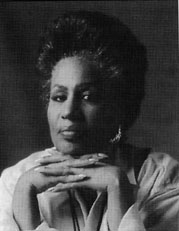Ethel Llewellyn Ennis
1932-2019

Ethel Ennis, born and raised in Baltimore, is the essence of the "renaissance woman." Although an international jazz career takes up most of her time, Ennis devotes the remainder of it to community roles as a woman minority entrepreneur, a band leader, a cultural ambassador, and a civic activist.
Ennis' musical interests began at an early age. She began playing piano at age seven. It was a love that led to her first job in a local church. By fifteen, Ennis' love of music had grown to encompass rhythm and blues as a complement to her gospel and classical roots. In the late 1940s, Ennis joined a jazz group led by Abraham Riley in an effort to cultivate her piano and vocal skills in this genre. During the 40s, Ennis displayed her raw talent by winning a number of small, localized contests. However, her career did not take off until her graduation from high school in 1950.
At that time, Ennis began touring with a number of jazz and R&B artists that performed throughout the United States and London. International recognition finally surfaced in 1958 when Benny Goodman selected Ennis as the female vocalist for an "all-star band" that toured Western Europe and took the spotlight in the Brussels World's Fair. Ennis has performed with a number of accomplished jazz and R&B artists such as Louis Armstrong, Count Basic, Duke Ellington, Wynton Marsalis, and Ray Brown.
Nevertheless, it is Ennis' solo performances that may hold the most significance in her career. Many have claimed that she "set a precedent" with her a cappella version of the national anthem at Richard Nixon's inauguration. She continued to perform at the White House throughout Nixon's and Carter's presidencies. In 1982, Mayor William Donald Schaefer appointed both Ennis and her husband, Earl Arnett, Cultural Ambassadors of the City of Baltimore. This honor would eventually take her, in 1987, to the First International Music Festival in Xiamen, China.
Despite international acclaim and worldwide tours, Ennis has been able to avoid the trials and tribulations of fame by remaining in her hometown of Baltimore. Some critics cite this as a fault, but Ennis defends her choices in a biography entitled Ethel Ennis: The Reluctant Jazz Star, written by Sallie Kravetz in 1984.
Remaining in Baltimore has enabled Ennis to take an active role in civic duties. She was nominated to the Hall of Fame of Frederick Douglass High School and received an honorary Doctor of Fine Arts Degree from the Maryland Institute College of Arts. In recent years, Ennis has become involved in the award-winning children's program produced by the Maryland Department of Instructional Television called "Book, Look, and Listen"
In 1984, Ennis opened "Ethel's Place" - her own music club located in Baltimore's cultural district across from the Meyerhoff Symphony Hall. A great success, the club actually broadcast live on public television across the country on New Year's Eve in both 1985 and 1987. Ethel performed with Joe Williams, Ray Brown and Milt Jackson, Phil Woods, Gerry Mulligan, Toots Thielemans, Wynton Marsalis, McCoy Turner, and Stephane Grappelli in these memorable broadcasts. In 1988, Ennis and her husband Arnett, made the difficult decision to sell "Ethel's Place" in order to "devote their creative energies to words and music."
Ennis has survived and overcome many prejudices as a black woman, both in her professional and personal life. She uses her music as a weapon to combat prejudice and injustice throughout the world, by promoting love, compassion, and unity. Ennis refers to this power as "Soft Power", a "power within, the spiritual energy we all possess to change ourselves and the world around us." In this way, she believes music is not only a medium to be used for entertainment, but also a way to "inform and inspire."
